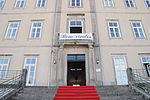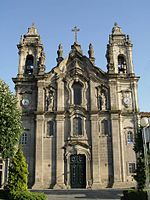Colégio Dom Diogo de Sousa
1949 establishments in PortugalBuildings and structures in BragaCatholic schools in PortugalEducational institutions established in 1949European school stubs ... and 2 more
Portuguese building and structure stubsPrivate schools in Portugal

The Colégio Dom Diogo de Sousa is a Catholic school located in São Vicente, Braga, Portugal. It's one of the most acclaimed and renowned schools in Portugal, usually in the top five nationwide it is also one of the most privileged schools in the whole country.Having good sport facilities like one basketball field, one volleyball field, a handball field, a football camp in the lower part, a huge football camp on the up part and two indoor swimming polls. It has renovated classrooms containing interactive boards and top qualities air conditioner. This Catholic school also embraces different religions, and people from various countries.
Excerpt from the Wikipedia article Colégio Dom Diogo de Sousa (License: CC BY-SA 3.0, Authors, Images).Colégio Dom Diogo de Sousa
Rua São Domingos, Braga Braga (São Vicente)
Geographical coordinates (GPS) Address External links Nearby Places Show on map
Geographical coordinates (GPS)
| Latitude | Longitude |
|---|---|
| N 41.5575 ° | E -8.4159305555556 ° |
Address
Colégio Dom Diogo de Sousa
Rua São Domingos
4710-435 Braga, Braga (São Vicente)
Portugal
Open on Google Maps










